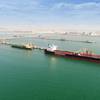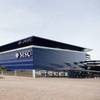Gas Ship Design Challenges
In terms of fleet numbers the total number of gas ships is small compared with oil tankers, general cargo ships or passenger vessels. The current overall fleet of gas ships in service is a touch over 1,000, of which about 800 are LPG carriers, and just over 100 are LNG carriers, with the 90-strong ethylene carrier fleet making up the remainder.
Secret Cargo
Cargo tank designs can range from those on fully pressurized LPG carriers, for service at ambient temperature, at a pressure of 18 bar, to those on fully refrigerated LNG carriers operating with cargo at -163 deg. C, at a pressure of 0.25 bar.
The first purpose built LPG carrier Agnita was delivered to the Anglo-Saxon Petroleum Company in 1931, as Hull No 578, from the north of England shipyard Hawthorn Leslie & Co. Ltd., Hebburn, on the south bank of the river Tyne. The ship was fitted with 12 riveted cylindrical pressure vessel tanks for butane, mounted vertically in her oil cargo tanks, with a total capacity of 1,200 cu.m and a design pressure of 5.5 bar.
In keeping to the ship-owner's request, having spent a great deal of money in constructing a vessel for a special trade, any reference to the fact that the vessel had been specially constructed for the carriage of high pressure petroleum products was to be avoided. Hence, the Particulars of Class in Lloyd's Register of Ships described the tanker as: Carrying Petroleum in bulk — Fitted with cylindrical tanks of Sulphuric Acid.
Today, 69 years on, there are many trading routes where butane and propane are still transported under pressure at ambient temperature. 44 percent of the total number of LPG carriers in service are fully pressurised ships, with most operating coastal services in Japanese, Korean and Chinese waters.
The most versatile group of gas carriers are the small to medium sized pressurised and refrigerated vessels, up to 30,000 cu.m, capable of loading and discharging a wide range of LPG and chemical gases. Generally designed for a minimum temperature of -48 deg. C, a maximum pressure of 5 to 8 bar and a liquid cargo density of 0.97 for vinyl chloride (vcm), with independent low temperature steel cargo tanks.
Of similar capacities are ethylene carriers but with cargo tanks and cargo handling systems designed for a cargo temperature of -104 deg. C and constructed with nickel steels or stainless steels.
The larger LPG carriers, up to 100,000 cu. m, are fully refrigerated, with low temperature steel prismatic cargo tanks designed for a minimum temperature of -48 deg. C and a maximum pressure of 0.25 bar. The independent cargo tanks are not directly connected to the ship's structure, but are positioned with steel and timber supports, chocks and keys, which hold the cargo tanks in place.
LNG carriers are in service up to 138,000 cu.m capacity and are also fully refrigerated, with material in direct contact with the cargo being able to withstand an operating temperature of -163 deg. C. Current designs incorporate independent aluminium alloy cargo tanks or have membrane containment systems. Independent spherical tank designs have a distinctively recognizable profile with the upper half of the tanks prominent above the main deck, while prismatic tank designs have a flush deck arrangement. In the case of the more compact membrane systems, stainless steel or 36 percent nickel steel invar is used as the primary barrier.
Safety Features
No matter what the size or type of gas ship, ranging from the fully pressurised 1,500 cu.m An Long, trading between Chinese ports, to the 135,000 cu.m Zekreet, moving LNG from Qatar to Japan, they all need additional safety features to ensure the safe carriage of the cargo.
Cargo tanks must be protected from damage from grounding or collision. Accommodation and main machinery spaces need to be separate from the cargo area. Electrical installation are to be flame proof and intrinsically safe.
Cargo piping systems need to be free to contract and expand under the temperature changes, and free to move with cargo tank or hull deflections. Pressure relief systems should be fitted at each cargo tank and throughout the cargo piping, set to lift at the design limit of the system.
An emergency shut-down system is require to operate automatically in the event of loss of electrical or control power, valve actuator power or fire at the cargo manifolds or at the tank domes.
Fire protection and fire extinguishing ystems are required, including structural protection, water main, water spray, dry chemical powder and fixed fire extinguishing systems in enclosed gas-dangerous spaces.
Extensive instrumentation is require to monitor all aspects of the cargo handling systems. Level indicator, liquid level alarms, pressure gauges and thermometers are fitted throughout the cargo tanks and cargo handling systems. Crew members engaged in cargo operations require suitable safety equipment.
Steady Progress
Since that important day of 20th March 1931 when Agnita was delivered to her owners the development of gas ship technology has been gradual and steady. Safety is always of paramount importance. This is represented in the outstanding progress made to arrive at today's sophisticated LNG, LPG and ethylene carriers fleet.
About the Author
Naval architect and marine surveyor Syd Harris has been involved with liquefied gas carriers for over 25 years. An independent consultant since 1978, he invites you to visit his web page at www.fsharris.co.uk.












